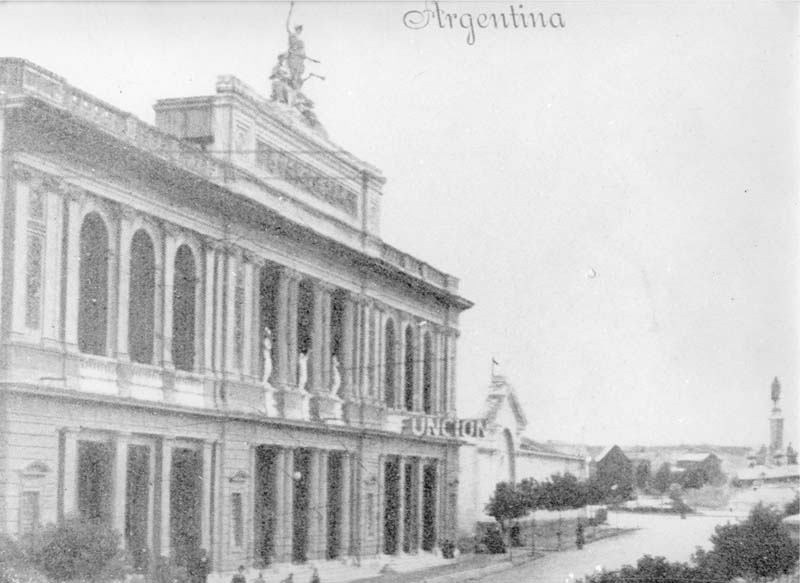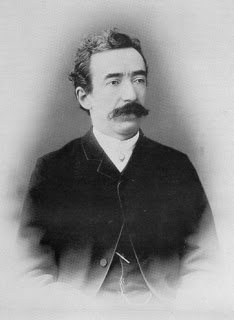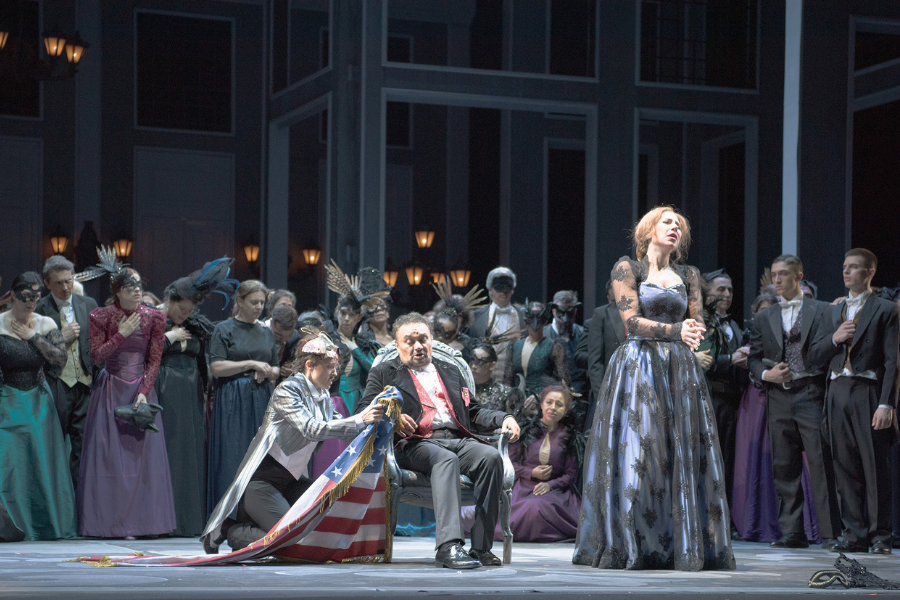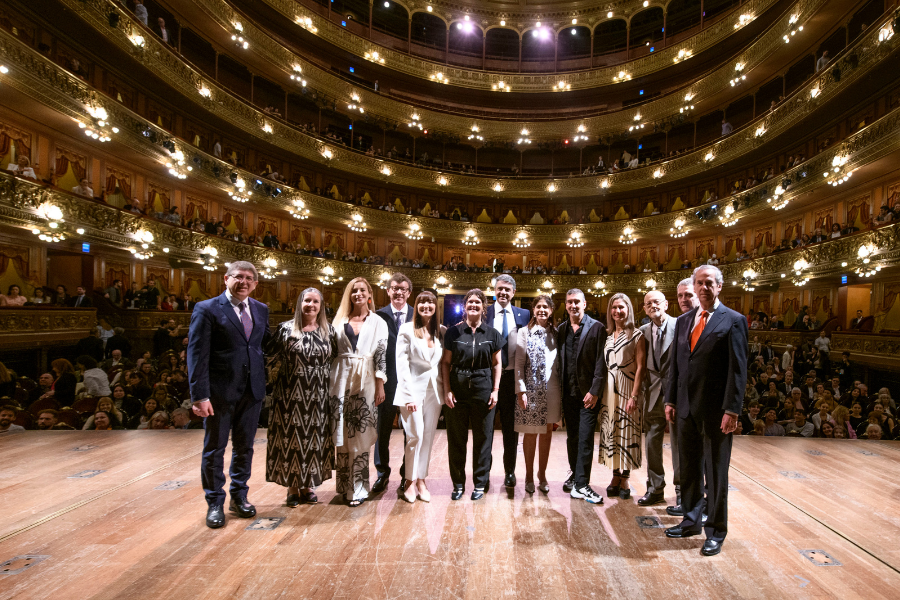Teatro del Libertador General San Martín de Córdoba, the resurrection of time

After an ambitious and extensive project to upgrade and update technology that began in 2017, the Teatro del Libertador General San Martín de Córdoba was reborn in all its splendor for the VIII International Congress of the Spanish Language in 2019. The Cordovan Coliseum, inaugurated in 1891 and currently directed by the Colombian Hadrian Ávila Arzuza, today it stands out for being a space where the traditional aesthetics of theater coexist with the most modern technologies. In this installment of our Theater of the Month section, we investigate the history, architecture and artistic projection of the Teatro del Libertador, a jewel of Latin American cultural heritage.
by Álvaro Molina R.
In November 2017, the task seemed daunting. The Teatro del Libertador General San Martín, in Córdoba, Argentina, would enter a long process of restoration, enhancement and technological updating to recover its former splendor, consolidated in more than 130 years of history. The remodeling work was carried out by the Córdoba government, directed by Juan Schiaretti, and the architect Gabriela Casanovas, in addition to a call for more than 300 professionals who came from different disciplines such as architecture, historiography and the arts.
The project of 450 million Argentine pesos was not easy; In addition to meticulously maintaining the original appearance of the theater, the façade also had to be remodeled, the security and electrical installations modernized, the capacity of the stage expanded, and the paintings, curtains, artistic ceilings, sculptures, and the 1,200 bronze seats available for the public. All this work, against the clock; the renovation of the Teatro del Libertador should be ready for the VIII International Congress of the Spanish Language (CILE), held in March 2019.
After just over 15 months of intense work, on March 27, 2019, the Teatro del Libertador was reborn as the venue for CILE. “The Teatro Libertador General San Martín, the jewel that Córdoba recovered for the International Congress of the Language”, headlined the newspaper Clarín a few days before the start of the congress. “The Teatro del Libertador shines again as in 1891,” said Comercio y Justicia, referring to the year the theater was inaugurated. “The Teatro del Libertador San Martín reopened in all its splendor” considered the Cordovan media El Acontecer.
After this enhancement and technological update, today the theater is directed by the Colombian Hadrian Ávila Arzuza, musical director of the Cordoba Symphony Orchestra for 16 years, who shortly after assuming his management, explained that the theater “would be a laboratory for thinking about new experiences”, with the return of opera through its own productions, among other objectives and challenges for the future of “del Libertador”, declared a national historical monument in 1991.
In this new installment of our Theater of the Month section, we review the history, architecture, and historical and heritage value of the Teatro del Libertador, the jewel that Córdoba recovered.
A new theater for Córdoba
The Teatro del Libertador General San Martín is located in the heart of Córdoba, at number 365 of Avenida Vélez Sarsfield or “Calle Ancha” and a few blocks from Plaza San Martín. It is part of a list of buildings that make up a heritage circuit of the city, among which are other national historical monuments such as the Cathedral of the City of Córdoba, the Banco de la Provincia and the Provincial Legislature.
Currently, the theater houses the stable bodies of music, song and dance of the province, which regularly perform in concerts, recitals and shows open to the public. The seasons of chamber music, symphonic music, opera and ballet make the city an important cultural and artistic pole both at the level of the province of Córdoba and at the national level.
This active cultural life had its beginnings in the mid-19th century, when a large migratory current brought with it the influence of shows such as opera and zarzuela, with productions brought from Europe to be represented. Before the Teatro del Libertador, there were already other theaters in Córdoba, such as the Progreso and Edén theaters (built in 1887) and the Teatro Argentino (built in 1889).
Towards the end of the 1880s, plans to provide the city with a larger theater began to come to fruition. Cordovan society longed for a new space that followed the philosophy of architecture linked to liberalism of European influences, classical forms and greater comfort to innovate the modest colonial and Creole constructions.
The government minister Ramón J. Cárcano at that time was a close adviser to Ambrosio Olmos, governor of the province of Córdoba. Cárcano insisted that the city needed a new coliseum to expand its cultural offer. In 1887 work began on the Teatro Nuevo (name by which the project was initially known), which would be one of the largest cultural projects in Argentina at that time.
The call for the design of the architectural plans was attended by the Italian Francesco Tamburini, who was already a well-known face in those parts; He participated in the expansion of the Casa Rosada and in the construction of the Teatro Colón in the Argentine capital, in addition to the design of other emblematic projects such as the Banco de la Provincia de Córdoba and the Hospital de Clínicas.
Tamburini’s plans referenced European coliseums, specifically those in the style of Palladian Mannerism instilled since the Italian Renaissance by the architect Andrea Palladio. In addition to this aesthetic line, the venue for spectators would be divided into: stalls, low box, high box, casserole, social gathering and paradise.
Among the people who participated in the construction of the theater are the architect José Franceschi, in charge of directing the works that were located on public land adjacent to Representantes street (today Vélez Sarsfield Avenue), near one of the barracks and the city jail. Antonio Subirá, for his part, had close ties with the highest merchants in Córdoba, so in addition to building the floor of the stalls and distributing the decorations, he was in charge of managing the importation of the decorations for the operas Mephistopheles, Aida and La africana.
The sumptuous European furniture that adorns the theater was imported thanks to Arturo Piccinini, who also provided the upholstery. The artist Arturo Nembrini Gonzaga was in charge of sculpting the statues and the high relief on the high gallery of the theater façade; decorate -in a Pompeian style- the central vault, the gallery in paradise and the doors of the boxes; and adorn the ceiling and walls of the ground floor exterior vestibule.
According to sources collected by the Argentine historian Efraín Bischoff, around 1890 Nembrini Gonzaga was still painting cherubs, women covered with light tulle and stripes with exotic flowers. The artist was decorating a theater that could not yet open its doors because he was still waiting for a business initiative willing to bring a prestigious cast to inaugurate the theater. The curtain, however, would not take much longer to rise on the stage.
A flurry of names
The first night that the theater received the public occurred on April 26, 1891. The inaugural performance was a charity reception organized by the provincial government, which later gave way to other activities such as national commemorations, celebrations for schoolchildren, and shows. for the community.
The turn of the lyric came in July of that same year, with the representation of the comic zarzuelas Los diamonds of the crown and The white vest. In Efraín Bischoff’s chronicles on the history of theater in Córdoba, the performance of these zarzuelas had started later than expected. The ticket offices were overwhelmed and the ushers misplaced the owners of boxes already occupied by other spectators. Other testimonies gathered by Bischoff assure that this commotion was added to the whistling of the spectators of paradise, which disoriented the policemen who did not know what to do.

Velez Sarsfield street. Del Libertador Theater (at that time Rivera Indarte). In the background the still unbuilt land of the current Nueva Córdoba neighborhood. Cordoba Argentina).
Shortly after its inauguration, the theater was baptized by a journalist from the newspaper La Libertad as Teatro Rivera Indarte in reference to the Argentine poet José Ignacio Rivera Indarte. According to historical sources cited by Bischoff, this name was coined after a dance attended by important figures in Argentine history, including Dalmacio Vélez Sarsfield and Juan Gregorio Las Heras. The journalist in charge of writing a chronicle about the event rescued the name poet Rivera Indarte to refer to the theater.
Starting in 1895 and during the first half of the 20th century, the theater began to receive a varied offer of international musicians such as the Vienna Symphony Orchestra, renowned Italian artists such as the soprano Luisa Tetrazzini and the tenor Enrico Caruso, the actresses Lola Membrives and Margarita Xirgú, or the Spanish composer Manuel de Falla, who in 1940 directed the Cordoba Symphony Orchestra, founded as a stable group in 1932.
The coming and going of the name by which the theater was known continued well into the 20th century. In 1950, a provincial decree ruled that the building should be renamed Teatro del Libertador General San Martín. Six years later, a new ordination of the government restored its first denomination. It was not until 1973 that the theater retained the name by which it is known to this day.
Where tradition coexists with modernity
The restoration that the Teatro del Libertador began in 2017 was not his first surgery. Between 1925 and 1927 the upholstery, electrical installations, heating and painting were repaired, in addition to the construction of new dressing rooms. During that period, the building also began to house institutional offices for the artistic and cultural development of the province, such as the Provincial Academy of Fine Arts and the Museum of Theater and Music of Córdoba.
More recently, in 2000 other interventions were necessary; An annex building was built that contains a room for lighting, a sewing and wardrobe workshop, a directors’ room, dressing rooms, rehearsal rooms, machine shops and a patio for artists.
The dream of the rebirth of the Teatro del Libertador began to materialize when in December 2018 Governor Juan Schiaretti attended the inauguration of the façade, whose restoration was in charge of Alicia Beltramino. Once the ornamental lights were turned on, the building reconnected with its history. “This restoration where the friezes appear that have not appeared for a long time and with the original colors, is made by young plastic artists from our Córdoba who have put their soul, their heart, as well as their talent so that this façade shines,” he said. at that time the governor Schiaretti.
The culmination of this enhancement took place on Tuesday, March 19, 2019, when the theater reopened its doors to make the meticulous work carried out by hundreds of professionals shine, restoring an aura of historical authenticity to the building, where it was modern and ancient coexist in harmony.
Today, for example, some of the curtains that hang over the stage continue to use the centuries-old system of pulleys and belts to slide while they coexist with more modern beams powered by electricity. The reminiscences of a past that could not go away and that coexists with different eras and styles are expressed in the Milanese curtain with an Italian drop (it opens and closes from the sides to the center) that coincides with a French guillotine-style curtain (it falls straight to the floor).
In charge of this new stage that the Teatro del Libertador is going through is Hadrian Ávila Arzuza. Born in Barranquilla, Ávila was in charge of the Cordoba Symphony Orchestra for 16 years before currently serving as theater director.
«The soul of the theater are the operatic shows and the ballet. We have all the infrastructure to carry them out, we want there to be a high-class season, that tourists from other places visit us, and are amazed by the level they are going to find, “Ávila told the Córdoba government news agency in 2021 .
Among the projects that he has in mind today, the director of the Teatro del Libertador highlights the commitment to empower established professional stable bodies, while accompanying new talents. This is how the theater, through its three training bodies, is constantly opening auditions and schools for seasons and integrating different educational projects in Córdoba.
Regarding poetry and its future both at the Teatro del Libertador and in Latin America, Ávila reflected in an interview for Ópera Latinoamérica that: “you have to know how to transmit your message to children and youth, generate creative proposals with a strong educational imprint. It is also necessary to ensure that the different disciplines that participate in the realization and production of an opera can be transmitted to new generations that could be interested in working on these trades. You have to generate a school to be able to stay ».

Production of the opera The Magic Flute (Mozart) presented at the Teatro del Libertador. Photo: Libertador Theater Press.
In its last seasons, the Teatro del Libertador has received lyrical productions of the stature of Eugenio Oneguin (Tchaikovsky); Lucia de Lammermoor (Donizetti) and The Magic Flute (Mozart). The program also includes classic ballet titles such as Tchaikovsky’s Swan Lake, lyrical oratorios with a high emotional and musical impact such as Carl Orff’s Carmina Burana and also symphonic and chamber music concerts that reflect the legacy of the Baroque or Romanticism, but they also open spaces for compositions by Argentine artists, from the traditional ones like Guastavino to the most eclectic and avant-garde like Marcos Franciosi.
With 130 years of history polished and restored in its rooms, corridors, ornaments and its stage, the Teatro del Libertador little by little returns to generate a school in the Cordovan and Argentine arts. Its permanence is linked to the inseparable history of a city and the enhancement that was given to it.










